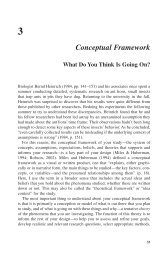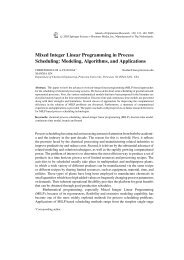Qualitative Research Basics: A Guide for Engineering Educators
Qualitative Research Basics: A Guide for Engineering Educators
Qualitative Research Basics: A Guide for Engineering Educators
You also want an ePaper? Increase the reach of your titles
YUMPU automatically turns print PDFs into web optimized ePapers that Google loves.
Using database software <strong>for</strong> data management involves the following:<br />
• Creating fields <strong>for</strong>, at minimum, the ID number and location of the segment, the<br />
category of the segment, the theme(s) represented by the segment, and the text of<br />
the segment<br />
• For each coded segment, pasting the selected text from the original document to<br />
the text field<br />
• Filling in the ID number and category name <strong>for</strong> each segment (the themes will be<br />
entered later)<br />
For example, two records might look like this (the theme field will be discussed later):<br />
ID Location Category Theme Text<br />
7 Transcripts,<br />
p. 118<br />
5 Transcripts,<br />
p. 87<br />
Time Selfpacing<br />
Fit Critical<br />
mass<br />
In high school, my parents made me<br />
study at night, but here, I had to decide<br />
when and how much to study and I got<br />
caught up in other things and never got<br />
around to it.<br />
I looked around and there wasn’t<br />
anybody like me in the class or really in<br />
the whole engineering school.<br />
Essentially, an electronic grid of numbered segments (records) is being created <strong>for</strong><br />
storage and sorting. Spreadsheets can serve the same function, although special database<br />
programs are more suited <strong>for</strong> more complicated text manipulations. Selecting the<br />
“memo” option during creation of the text segment field in Access expands the amount of<br />
text allowable in the field.<br />
Displaying the Data<br />
Even when the data have been reduced in quantity and coded carefully, it is hard to<br />
develop a sense of the patterns and meanings they suggest until they can be visually<br />
scanned in their categories. Some researchers cut and paste the coded data at this point on<br />
to long sheets of paper or group together index cards on which they have pasted the<br />
segments of interest; those using computers sort their records and visually scan them or<br />
obtain printouts by category. In the example above, separate printouts or screen displays<br />
of each category (time, fit, money, etc.) would be made, allowing the researcher to look<br />
at all the text segments that have been placed into this category together. Ways of<br />
displaying the data will vary according to the resources that the researcher has, the type<br />
of data and study, and the amount of data on hand. Through looking at the assembled<br />
segments, the researcher can decide to change the category label in the field, to move<br />
some segments to other categories where they fit better, to split one category into more<br />
than one and recode the segments accordingly, or to rename to category or readjust its<br />
46
















